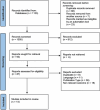The Role of N-terminal Pro-B-Type Natriuretic Peptide, Troponins, and D-dimer in Acute Cardio-Respiratory Syndromes: A Multi-specialty Systematic Review
- PMID: 40546647
- PMCID: PMC12180772
- DOI: 10.7759/cureus.84460
The Role of N-terminal Pro-B-Type Natriuretic Peptide, Troponins, and D-dimer in Acute Cardio-Respiratory Syndromes: A Multi-specialty Systematic Review
Abstract
This systematic review evaluates the diagnostic and prognostic utility of N-terminal pro-B-type natriuretic peptide (NT-proBNP), cardiac troponins, and D-dimer in acute cardio-respiratory syndromes, including heart failure (HF), acute coronary syndrome (ACS), pulmonary embolism (PE), acute respiratory distress syndrome (ARDS), and coronavirus disease 2019 (COVID-19)-related complications. These biomarkers play critical roles in assessing myocardial stress, injury, and thrombosis risk, offering a rapid and cost-effective alternative to traditional diagnostic tools. A comprehensive literature search from 2015 to 2024 identified 14 high-quality studies, demonstrating NT-proBNP's strong correlation with HF severity and mortality risk in severe COVID-19, while cardiac troponins were associated with myocardial injury in ARDS and ACS. D-dimer emerged as a predictor of thrombotic complications and poor outcomes in interstitial lung disease (ILD) and PE. The combined use of these biomarkers significantly improved risk stratification, enabling early intervention and reducing unnecessary imaging and invasive testing. A multi-marker approach provided superior predictive accuracy for mortality and recurrence risk in PE compared to single biomarker assessments. Despite some methodological limitations, including heterogeneity in biomarker thresholds, the findings support the integration of these markers into routine clinical practice to enhance early diagnosis and patient management. Future research should focus on standardizing biomarker cut-off values, conducting large-scale multi-center trials, and incorporating biomarker data into artificial intelligence (AI)-driven decision systems. This study highlights the potential of biomarker-driven risk assessment in cardio-respiratory medicine, paving the way for more precise, early, and effective intervention strategies to optimize patient outcomes and advance precision medicine in critical care settings.
Keywords: biomarkers; cardio-respiratory syndromes; d-dimer; nt-probnp; troponins.
Copyright © 2025, Ibrahim et al.
Conflict of interest statement
Conflicts of interest: In compliance with the ICMJE uniform disclosure form, all authors declare the following: Payment/services info: All authors have declared that no financial support was received from any organization for the submitted work. Financial relationships: All authors have declared that they have no financial relationships at present or within the previous three years with any organizations that might have an interest in the submitted work. Other relationships: All authors have declared that there are no other relationships or activities that could appear to have influenced the submitted work.
Figures
Similar articles
-
The comparative and added prognostic value of biomarkers to the Revised Cardiac Risk Index for preoperative prediction of major adverse cardiac events and all-cause mortality in patients who undergo noncardiac surgery.Cochrane Database Syst Rev. 2021 Dec 21;12(12):CD013139. doi: 10.1002/14651858.CD013139.pub2. Cochrane Database Syst Rev. 2021. PMID: 34931303 Free PMC article.
-
Prognostic Utility of N-terminal Pro-B-type Natriuretic Peptide (NT-proBNP) for Predicting Hospital Readmissions in Patients With Heart Failure: A Systematic Review of Clinical Evidence.Cureus. 2025 Jun 2;17(6):e85242. doi: 10.7759/cureus.85242. eCollection 2025 Jun. Cureus. 2025. PMID: 40605900 Free PMC article. Review.
-
Brain natriuretic peptide and N-terminal brain natriuretic peptide for the diagnosis of haemodynamically significant patent ductus arteriosus in preterm neonates.Cochrane Database Syst Rev. 2022 Dec 8;12(12):CD013129. doi: 10.1002/14651858.CD013129.pub2. Cochrane Database Syst Rev. 2022. PMID: 36478359 Free PMC article.
-
Systematic review and individual patient data meta-analysis of diagnosis of heart failure, with modelling of implications of different diagnostic strategies in primary care.Health Technol Assess. 2009 Jul;13(32):1-207, iii. doi: 10.3310/hta13320. Health Technol Assess. 2009. PMID: 19586584
-
Cost-effectiveness of using prognostic information to select women with breast cancer for adjuvant systemic therapy.Health Technol Assess. 2006 Sep;10(34):iii-iv, ix-xi, 1-204. doi: 10.3310/hta10340. Health Technol Assess. 2006. PMID: 16959170
References
-
- Unraveling the complex interplay: COVID-19 and heart failure: a comprehensive review. Deiveegan DS, Singh A, Shazi MI, et al. J Adv Med Med Res. 2024;36:160–176.
-
- Improving outcomes for severe sepsis and septic shock: tools for early identification of at-risk patients and treatment protocol implementation. Rivers EP, Ahrens T. Crit Care Clin. 2008;24:0–47. - PubMed
-
- NT-proBNP: the gold standard biomarker in heart failure. McKie PM, Burnett JC Jr. J Am Coll Cardiol. 2016;68:2437–2439. - PubMed
Publication types
LinkOut - more resources
Full Text Sources
Research Materials
Miscellaneous

